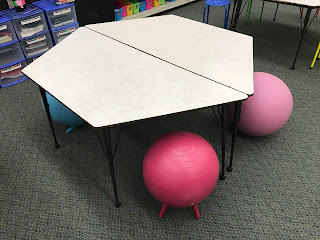Flexible seating has been a hot topic for the past few years. I began to implement it three years ago, with some flexible seating options. When I first began, I wasn't ready to fully jump into flexible seating, so I found other ways to slowly transition. If you're like me, I hope these steps help you to make the switch. Our students' needs are so different than ours were when we were in school and I love how flexible seating gives them more comfortable ways to learn!
Have specific seat rules.
When I first began, I had "special seats" that you chose and took back to your desk to replace your chair or make your chair more comfortable. Each seat had specific rules about how to use it, and we had a plan in place for what order students got to choose their seats.
After I began full implementation, the seats stay where they are and you move to the seat you want. This works well for my class and I love that things aren't moving around anymore.
Either way, the students needed clear rules on where the seats can go and how to use them. Exercise balls are a great example because those can easily be misused, as I'm sure you can imagine. Balls must stay on the ground and you can only gently bounce. Lap desks have a specific place they can be used. Stools must stay on all four legs. You get the idea. Just be clear with your students. If anything gets misused, I add rules or change how the seat is used.
Not ready to jump into flexible seating but like the idea of choices? When I first started, I was not ready to give up the desks. I wanted a place where they could go back to their seats when I wanted everyone together. So, I found a way to incorporate their choice to this comfort for myself. It worked well at the time. They chose their seats in the morning when I drew their stick, they stacked their chairs and took it to their desk.
Once I was ready to fully transition, it was important that the seats stayed in their place. This helps students know the rules of the seats, and it also helps students from sitting by their friends. They quickly learn that choosing a seat next to their friend may not be the best choice for them. If they want to sit in a different type of seat, they move to the seat.
Make a routine for choosing.
My class uses a magnetic choice board. My neighbor teacher has the students place their pencil pouch wherever they want their seat for the next day. Just make sure it becomes a routine. We choose our seats for the next day at the end of the day. This makes your mornings much easier as they can come in and go directly to their seats. Of course there are days that get crazy and we run out of time to choose, but it definitely makes the mornings a little crazier. Whatever way you decide to choose seats, make a routine out of it, as with everything we do in our classrooms.
My choice board is from Aly (Just A Primary Girl) and you can find them here!
My choice board is from Aly (Just A Primary Girl) and you can find them here!
Make supplies accessible.
I have always had tables, not desks, so I already had to have alternatives to storing materials. However, if you are getting rid of desks, you'll need to find ways to store supplies. I like putting supplies together as much as possible, so I collect all of their markers, colored pencils, crayons, etc. at the beginning of the year and we keep them in buckets. Then, each table has a bucket that all students share. Then, I use these 3 drawer stands for students supplies. This is an investment at first, but mine have lasted four years so far (a couple drawers have tape holding cracks). I also made pencil cups out of Pringles cans covered in duct tape, but you could also use the zipper pouches or their own pencil cases. I have specific rules on what is allowed in the pencil cups (and have random checks where they can earn brag tags), to keep them from carrying too much around to each spot.
Find what's best for you.
As I have said several times, I was nervous about changing to flexible seating at first, but it was such a great decision. If you are still debating, I hope that these steps will help you make an easier transition. It is seriously so worth it! I have parents who come in and look around and ask where the desks are, but if they could see my room when everyone is focused, they wouldn't even notice that there aren't desks!








No comments
Post a Comment